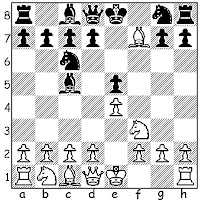1.e4 e5 2.Nf3 Nc6 3.Bc4 Bc5 4.Bxf7+ ...and related lines
(risky/nonrisky lines, tactics & psychology for fast, exciting play)
Monday, May 6, 2013
Take your chance when you get it...
When I get a new bunch of games, I like to see what has been happening in some of the most important lines. The following game explores Whistler's Defense, a very dangerous line for White to deal with. Once again, we see that although a refutation may exist in the books, it may not easily make it to the board. The first player loses only after missing his chance to escape.
franciskov - danielhidrobo
blitz, FICS, 2013
1.e4 e5 2.Nf3 Nc6 3.Bc4 Bc5 4.Bxf7+
4...Kxf7 5.Nxe5+ Nxe5 6.Qh5+ g6 7.Qxe5 Qe7
A wicked "improvement" on the 7...d6 of Amateur - Blackburne, London, 1884 - first played almost a decade earlier, but largely forgotten.
8.Qxh8
White should not be able to take the Rook and live.
8...Qxe4+
An innocuous sideline is 8...Qf6 9.Qxh7+ Kf8 10.0-0 Black resigned, Wall,B - Sepoli, Chess.com 2010.
9.Kd1
9.Kf1 is better, as in Jerome,A - Norton,D, Correspondence 1876 (½-½, 20)
9...d5
Black does not realize what an opportunity he has in 9...Qxg2. See blackburne-perrypawnpusher/JG3 thematic, ChessWorld.net 2008 (0-1, 17), but don't overlook Wall,B - Mathieubuntu, FICS, 2011 (½-½,14).
9...Qg4+ 10.f3 Qxg2 is a similar kick in the head, Jerome,A - Whistler,G, Correspondence 1876 (0-1, 15).
10.Re1
Taking a shot at the enemy Queen, but overlooking his light-square weakenesses. Necessary was 10.Qxh7+ Kf6 11.f3, safe-guarding both his Queen and King, when he can cobble together a defense, according to Rybka: 11...Qg4 12.Rg1 Qd7 13.Qh8+ Qg7 14.Qxg7+ Kxg7 15.Re1. White is up the exchange and two pawns.
Now Black finishes things off.
10...Bg4+ 11.f3 Bxf3+ 12.gxf3 Qxf3+
13.Re2 Re8 14.Qxh7+ Kf8 15.Nc3 Qf1+ 16.Re1 Qxe1 checkmate






No comments:
Post a Comment